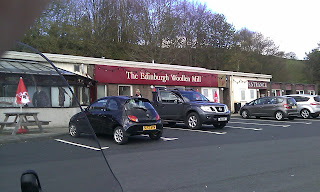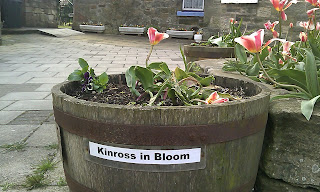Scotch Corner to Kinross
A nice early start - 0730 or so. I was conscious of having dithered around so much in the South that I would need to do some long legs to make up time. Apologies to Gaynor and family for not calling in. Perhaps we'll all meet up again in Cotterdale. (Everybody else: do google up Town Head House, Cotterdale, for a really magical holiday destination.) Anyway, there were blue skies and fluffy clouds, but they got a little less fluffy as the day went on, producing some short, sharp showers. And it was plenty windy as I went up and over the Cheviots and the Southern Uplands, too, but it was still a fine day for a ride, all in all.Piercebridge and the B6275
Just North of Scotch Corner, the A1M swerves off to the East, possibly drawn by the gravitational pull of Darlington and Sunderland.But I noticed on the map, a little B road carrying on in a dead straight line - the sort of thing that usually indicates an old Roman road. It joins up with the A68 after a few miles, which is where I was heading anyway, so I had to have a look.
The B6275 does a bit of a zig-zag where it crosses a river in the village of Piercebridge. Arriving there early enough to scare the bunny rabbits out of the bluebells and wild garlic, I had a bit of a snoop around and found the remains of a Roman bridge. There are the remains of a fort that once guarded it somewhere nearby, too, but I thought I'd let the bunnies get back to their breakfast rather than try to find that. Reading all the information boards I could find, I learned that the road follows the Roman Dere Street and the river is the Tees. The bridge got buried under a causeway as the river moved Northwards and its footings were unearthed in modern times during quarrying.
"Time Team should have done an episode here," I thought, then I found out that they had. I must've missed it that week.
Your bridge has gone, Biggus. But then so has the river, so you won't get your sandals wet.
If a theme of my 'placeholder' trip last year was plaques, this trip seems to be becoming marked by bridges. There was the Queen Elizabeth crossing at Dartford, the Humber, and now this one; not quite as functional as the others, but arguably as significant historically speaking.
Wall
It's a standing joke between me and Mrs S that, for all the times we've driven to Scotland and back, and despite the fact that it is one of our biggest ancient monuments and stretches across the country from coast to coast, we've never managed to see Hadrian's Wall! This trip, I was determined to put that right and spotted a place called 'Wall' on the map. That, surely, is the place to go.
Crikey, Biggus! Now your wall's gone, too.
What I found was a pretty little village. Village pump and war memorial on the green. But no wall. Maybe the pretty little houses are made out of robbed bits of wall? There was not a soul about to ask, so that will remain a small mystery.
But determined not to be thwarted this time, I set off again following the brown tourist signs for a bit of wall. Not far away, I came to the remains of a roman fort that actually straddled the wall at Chesters. One of the substantial bits of remaining stonework was the guardhouse at one end of the fort which was built right up against the wall. And there it was; six foot or so of genuine Hadrian's Wall. At last!
The bit running out to the right; that's Hadrian's Wall, that is.
Jedburgh
It may not be a primary tourist destination, but Jedburgh has its share of 'brown sign' destinations. There's a huge ruined abbey, and Mary Queen of Scots had a gaff around here somehwere. But to my mind, Jedburgh's high point is the fact that it hosts the first Edinburgh Woollen Mill in Scotland. (Well, on the A68 approach, anyway.)
For those of you who don't know, EWM is a purveyor of fine quality togs and accessories. It appeals especially to the discerning older customer, with whom it is so popular that they often arrive by the coach load. The addition of a Costa Coffee and a loo at most major branches enhances its appeal yet further.
When I arrived, I could hardly believe it: there was a sale on! The helpful Helen confirmed that this was the case and that some items were even being offered for sale at half of their normal price.
It's a crying shame I was on my motorcycle and so only had room for a coffee.
Granton
Now moving on to Edinburgh, I had thought to stop at Leith. Perhaps I could find a policeman and ask him if he would dismisseth me. But that would be just too predicatable for words. Instead, I went on along the Firth of Forth another couple of miles to Granton. Like Leith, this was once a dockyard/industrial area and had become a bit run down and depressed. Like Leith, various initiatives were tried to get the local economy moving and tart the place up a bit. (I had a small part to play in that: supporting the council's initiative to boost local business, my employer, which has an office around the corner at Crew Toll, depatched me with a hastily customised version of my in-house 'how-to-wrote-proposals' workshop, to deliver to local businesses. I'm not sure how useful it was in the end.) Unlike Leith, these various initiatives doen't seem to have worked!When I was last there, some swish waterside flats were going up; a bit of a Docklands-style development would get some money moving in to the area. When I called by this time, the flats were finished, but many seemed unoccupied and the whole building looked just a little unkempt.
The proprietors of JoJo's, just around the corner - purveyors of the best and the cheapest cup of tea I've had in a long time - tell me that this is indeed the case. The firm responsible for one of the developments even went bust for want of buyers. "Can't give 'em away," they said in JoJo's.
Forth Road Bridge
Look! Another bridge! Well, with my thing about engineering works, I had to turn off for a couple of minutes to take a picture of the Forth Road Bridge.
Could this actually be the one in the background in the burial scene in Four Weddings?
But a real bonus for me was that they are starting work on another crossing just alongside. I couldn't resist spending a couple of minutes watching dumper trucks and diggers disassembling this small mountain to make way for the new approach road.
A Fifth Road Bridge?
Crook of Devon
The penultimate destination for the day was Crook of Devon. I'd seen it on the map and thought, 'heavens! What a place name!' I imagined some thief from down my way stealing up here in the night to escape the consequences of his crimes. Maybe he established himself here as a much loved and respected Laird before his wicked past was revealed and he cast himself into the torrent to end his miserable existence.Nah. The 'Devon' is the local river, and there's a bend - 'crook' - in it here. And Scottish place names have always got to be 'this-of-that,' haven't they? Bridge of Orchy, Boat of Garten, Firth of Forth, ... John o' Groats.
But the real point of interest in Crook of Devon - and my Pagan aquaintances should sit up and take note here - is that it is where ten women and one man were accused of being witches in 1662. The trial process finished a few of them off, and those that survived were either burned alive or strangled by the hangman and their bodies burned.
Lord Moncrieff, who has a nice little castle just near the town, is in the process of building a maze of beech trees to commemorate the innocent victims, but also to decry the ignorance and superstition that led to their trials and execution.
A nice little castle
Elsewhere in Scotland there is a stone memorial to Maggie Wall, executed as a witch in 1657. I know because Mrs S and I came across it by chance on a holiday in Scotland in our camper van a couple of years ago. The monument is nominally Christian in that there is a cross on top of it, but as you might imagine, the pagan community, especially Wiccans, have kind of comandeered it. Every nook and cranny contained a candle or the remains of some votive offering.
Moncrieff wanted none of that in his memorial to the Crook of Devon witches. In this maze, carved stones marking the correct path will commemorate humanist virtues like knowledge, reason, tolerance and so on. In the dead ends, you'll come across stones marked 'bigotry,' 'resentment,' 'racism' and the like. Sorry, Wiccans; no candles and chants and incence here.
The maze is work in progress at the moment, but Lord Moncrieff was kind enough to let me take a look, breaking off from pointing a wall to despatch his two hyperactive spaniels to show me the way. When we got to the maze, the dogs found something living in holes under a nearby hedge far more interesting so I went in on my own. After a couple of circuits of the circular maze, and being rebuffed by a 'perfidy' and a 'falsarii,' I began to realise that gettng to the centre was a substantial undertaking.
Labeled stumps do duty for carved stone pillars for now. Oh, and you do know what 'falsarii' are, don't you? Beware if you don't; a notice at the entrance tells children to call out the words loudly and ask grown ups what they mean.
When you finally get to the centre, you will find memorials to (and information about) the victims.
The truth is in there ... somewhere.
Lord Moncreif told me that he hopes to make Tullibole Castle a wedding venue. It's a beautiful place, and I imagine happy couples would be especially happy getting spliced here. (Those muddy spaniels will have to be trained to keep off the wedding dresses, though!)
Kinross
From Crook of Devon it was a short hop to my overnight stop at Kinross - Travelodge in the motorway services again; just the ticket. But since it was still only late afternoon, I went on to look at Kinross itself first. Travellers sometimes forget that there is a real town or village behind the service areas that carry their names. Some are pleasant, refined little settlements; some are unloved and down-at-heel. Exploring them could be a themed tour all on its own. Kinross seems to be a bit of a mixture. Down by Loch Leven, there is a beautiful public space with parking, kiddies playground, wheelchair-friendly paths, swish loos with electronic doors that talk to you like something from the Sirius Cybernetics Corporation.
Symbolic?
The town itself is more ordinary, though. It's certainly not 'run down,' though there are signs of it having once been a wealthier place than it is now. In fact, on the basis of nothing more substantial than looking around at the people and buildings, I thought it had that robust, chiseled-from-granite, last-forever, stoical-rather-than-joyful feel that so many Scottish towns have.
Kinross Town Hall: former civic splendor, now for sale and ripe for redevelopment.
















No comments:
Post a Comment